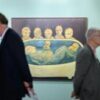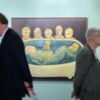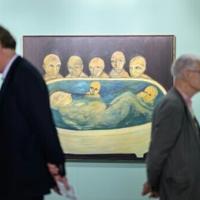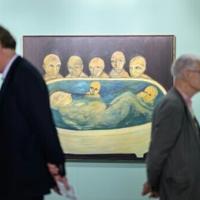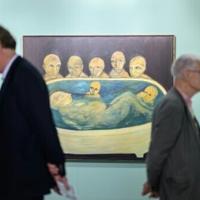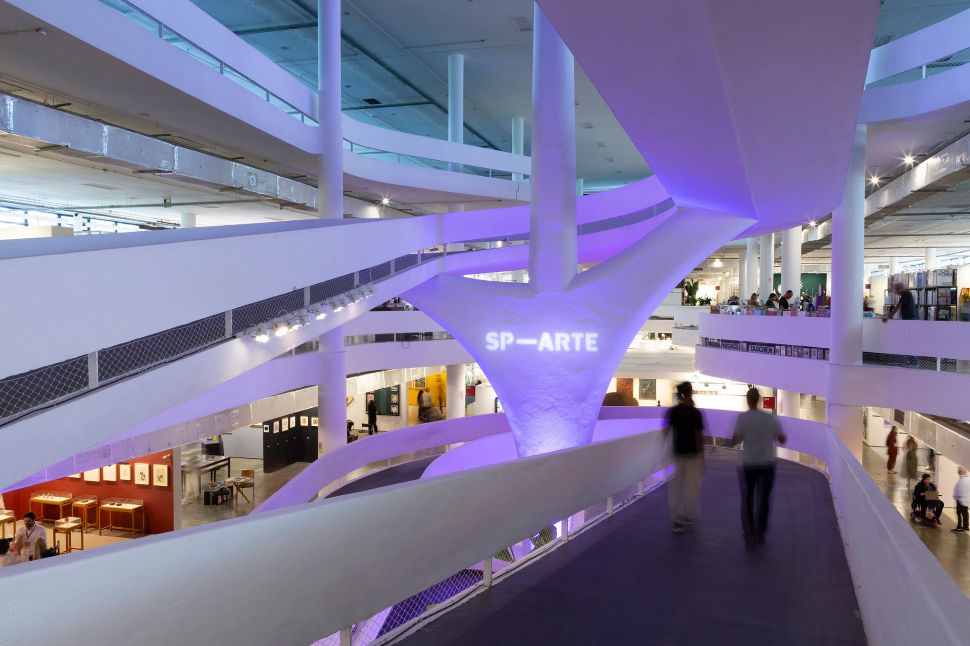
SP–Arte, Brazil’s leading art fair, opened yesterday (Wednesday, April 2) to VIPs in the iconic Pavilhão Ciccillo Matarazzo designed by Brazilian master architect Oscar Niemeyer. Animated since the early hours by the packed crowd of mostly Brazilian collectors, dealers were busy with negotiations and conversations until late into the evening—well after the fair closed at 9 p.m. This was mainly thanks to the thoughtfully designed arrangement of booths across the two floors, which provided the proper distance between them and created space for relaxation between browsing sessions.
Despite having to rein in its ambition to be the leading fair representing the entire South American region due to prohibitive import costs, SP–Arte managed to solidify itself as the premier platform to showcase and discover the Brazilian art scene. The roster of artists presented at the fair was largely Brazilian, and the early sales results are a testament to a healthy market supporting its own scene. As the fair’s founder Fernanda Feitosa told Observer in a recent interview, the Brazilian art market and its infrastructure are solid. “I can bet that the art market in Brazil is much better than if we look at the art market internationally,” Feitosa said. “Our artists are outstanding, and the collectors are very active. And global art market attention is now back on Brazil.”
The presence of several international blue-chip names at varying price points reflected the confidence and discernment of Brazil’s collector base. Meanwhile, Brazilian artists continue to gain momentum abroad, driven by a renewed spotlight on the Global South and the afterglow of the most recent Biennale.
As a Brazilian collector living in Munich and visiting for the fair told Observer, it’s too limiting to describe the Brazilian market as “regional”—given the country’s vast scale and the diversity of its contemporary production, it could be considered a continent in itself. Though international visitors were few, those who came via the fair’s well-orchestrated VIP program arrived with purpose and were committed to discovering the local scene, resulting in most making one or more purchases by end of day.
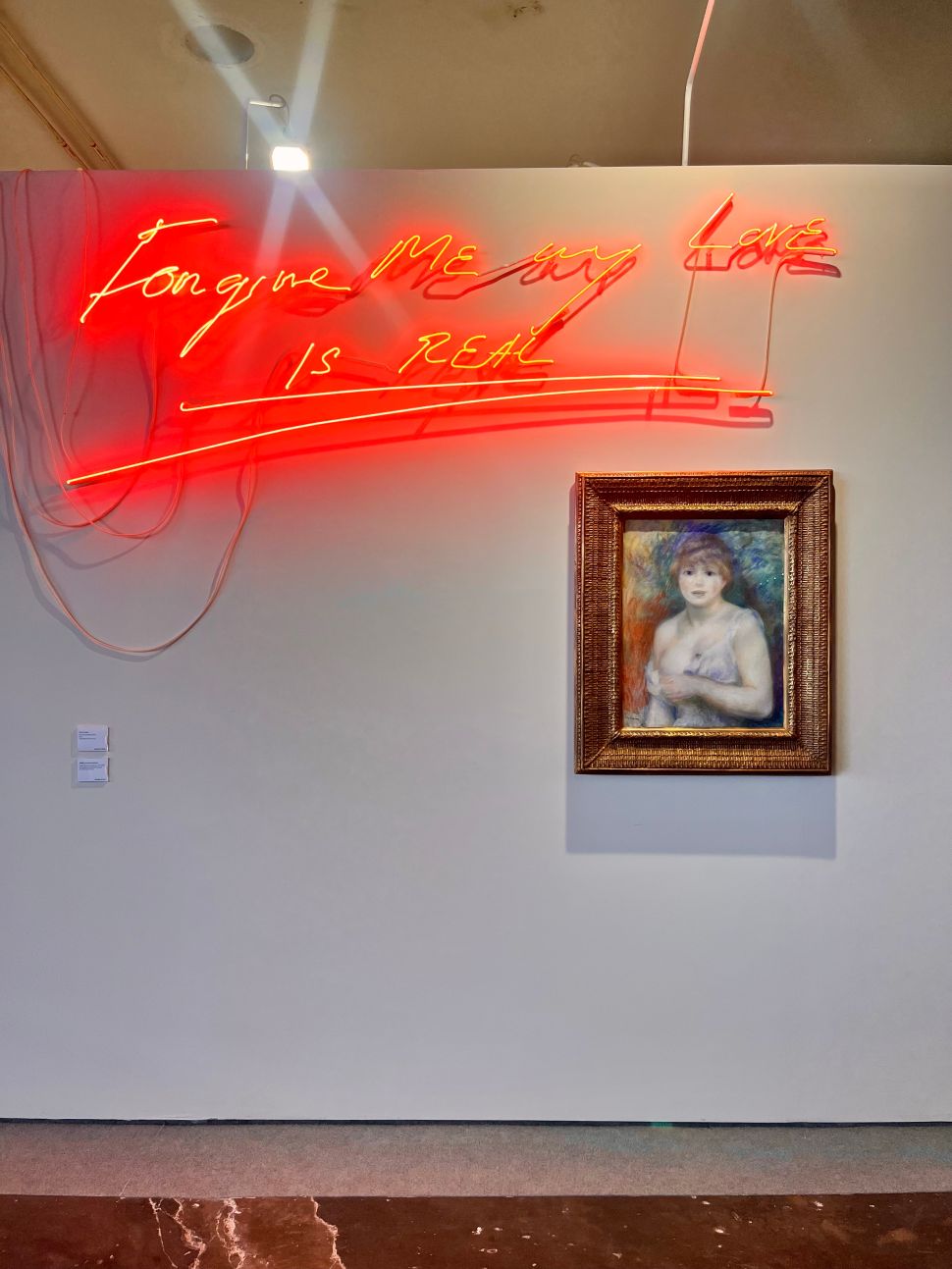
At the entrance, a striking pairing between Tracey Emin’s neon and a gentle Pierre-Auguste Renoir immediately signaled the level of this year’s SP–Arte—and the strength of the Brazilian market backing it. Local powerhouse Almeida & Dale presented both works in a booth that wouldn’t have looked out of place at Gagosian or Pace in Basel, anchoring a presentation that also included pieces by heavyweights like Rudolf Stingel, Stanley Whitney, Wilfredo Lam, Gabriel Orozco, Hélio Oiticica and Tom Wesselmann. A large Beatriz Milhazes canvas was presented in conjunction with her current solo show at the Guggenheim.
Just weeks before the fair, Almeida & Dale shook the Brazilian art world by acquiring the historic gallery Millan, taking over its three exhibition spaces in Pinheiros—one of São Paulo’s most desirable neighborhoods—as well as its entire artist roster.
SEE ALSO: Inside Eliana Hidalgo-Vilaseca‘s Mission to Put Ecuadorian Art on the Global Map
Nearby, Recife-based Galeria Marco Zero, known for championing artists from Brazil’s Northeast, presented a complex, large-scale work by Tereza Costa Rego. Rich with ancestral symbolism and labyrinthine narrative structure, the painting led viewers through an epic that was both personal and mythic. Nearby, Gomide&Co delivered one of the most compelling booths of the fair, balancing sophistication with risk. Among the standouts was a powerful ceramic work by Paraguayan artist Julia Isidrez, whose organic, earth-channeling forms echoed her inclusion in the last Biennale by Adriano Pedrosa. She shared the booth with Brazilian artist Maria Lira Marques, currently featured in a joint exhibition at the gallery. A 2004 textile work by Louise Bourgeois, shown inside a glass console, suggested a fragmented and decomposing body suspended in a moment of abandonment. Its quiet questioning of the limits between the physical and the sensorial came with a $2 million price tag.
Also in the Gomide&Co booth was another work by Beatriz Milhazes, whose presence at the fair felt almost omnipresent—her bold, patterned compositions echoed throughout SP–Arte, bolstered by her solo exhibition at the Guggenheim New York and new acknowledgment of the role she played in bringing painting back to the Brazilian art scene. One of her monumental works took over the entire exterior wall of Danielian’s space, its vibrant energy matched only by its $2 million asking price.
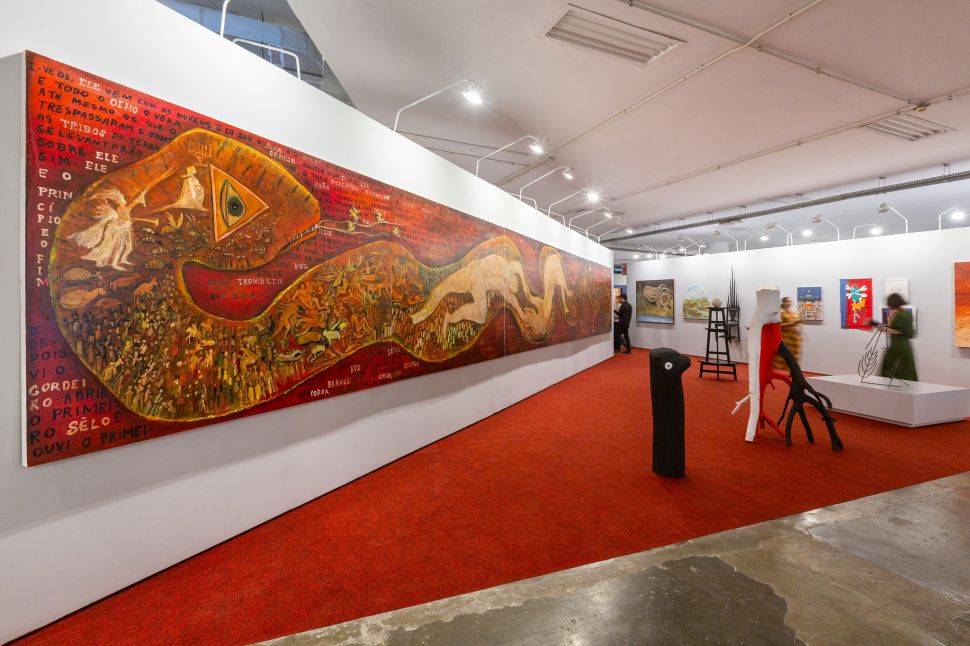



Beatriz Milhazes was also featured prominently in the booth of Rio de Janeiro–based gallery Flexa, shown alongside a commanding lineup of work by acclaimed international women artists. Among them: an extraordinary Infinity Net by Kusama, a new work by Golden Lion recipient Cecilia Vicuña and a delicately charged gouache by Marlene Dumas. Elsewhere, Galatea—a fast-growing gallery working confidently across both primary and secondary markets—mounted one of the fair’s most attention-grabbing centerpieces: a monumental, Picasso-inspired painting by Emiliano Di Cavalcanti, offered at 7.8 million reais (roughly $1.3 million). Nearby, Rafael Moraes dedicated his booth entirely to works on paper by Cavalcanti. The presentation highlighted not only the lasting imprint of Western modernism but also how Cavalcanti reinterpreted its legacy through a distinctly Brazilian lens—imbued with mysticism and a connection to the natural world.
In a more accessible register, Carbono, known for its focus on editioned works, presented a thoughtfully curated selection of new multiples. The booth featured editions by some of the most institutionally validated Brazilian and international artists, including Julio Le Parc, Iván Navarro and a newly released special edition by Ai Weiwei.
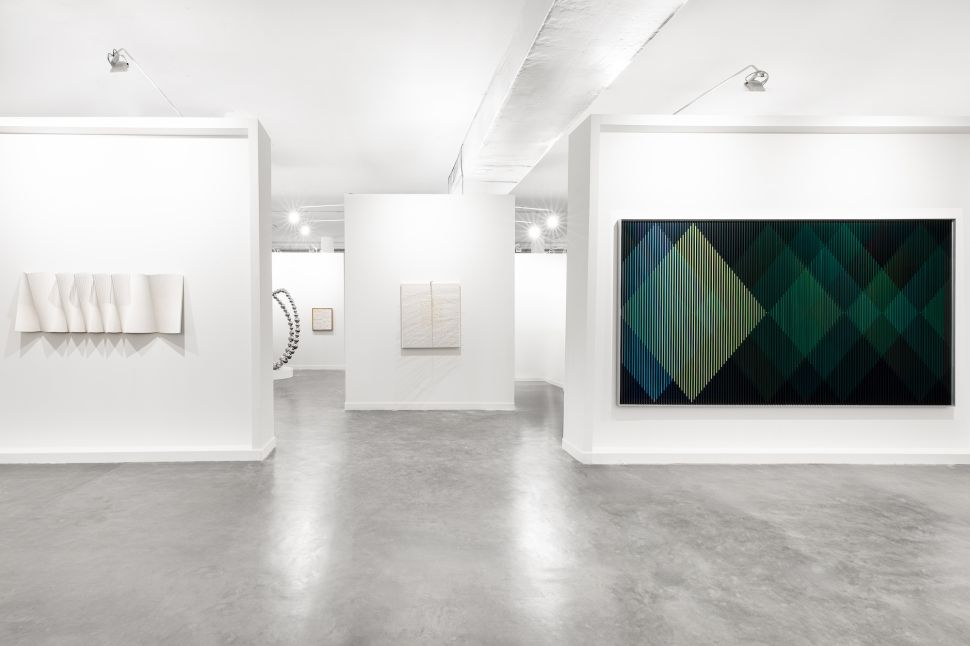



Also recurring across the booth were names associated with Brazil’s geometric abstraction, spanning from Concretism to Neo-Concretism, including, importantly, Lygia Pape, Lygia Clark and Hélio Oiticica. Works by masters of Latin America’s kinetic movement, like Jesús Rafael Soto and Carlos Cruz-Diez, were also present in several booths, with a standout being the over three-meter-long work by the latter, presented by longtime Brazilian dealer Simões de Assis with a multimillion price tag. Alongside works by other Brazilian masters like Sergio Camargo, the gallery also brought work by emerging names such as Zéh Palito, Thalita Hamamoui and Djambe. Simões de Assis’ presentation featured a group of international artists as well, including another multimillion red Infinity Net by Kusama, a large-scale sculpture by Jean-Michel Othoniel and works by Mexican artist Gabriel de la Mora. Simões de Assis recently began co-representing both Othoniel and de la Mora with Perrotin. Established in 1984 in Curitiba by Simões de Assis Filho, the gallery now operates alongside SIM Galeria—founded by Guilherme and Laura Simões de Assis—focused on contemporary art. In 2018, the two galleries expanded by opening a shared space in São Paulo, consolidating their programs and establishing themselves among the leading galleries in the country.
Fortes D’Aloia & Gabriel is another key player in internationalizing Brazilian contemporary artists, with a consistent presence at major international fairs. At SP–Arte this year, the gallery presented one of its strongest lineups, including a large-scale gestural abstraction by Janaina Tschäpe, who recently had a solo show at Kasmin in New York. The booth also featured works by other Brazilian artists now well-established on the global stage, such as Ernesto Neto, Erika Verzutti, OSGEMEOS, Leda Catunda and Yuli Yamagata. “We had a very exciting first day at SP–Arte. Sales were strong, and our booth remained busy throughout, reinforcing the public’s keen interest in our program and artists, both emerging and established,” Luiza Calmon, one of the gallery’s partners, told Observer. “The city is buzzing with curators and collectors from Brazil and abroad, many of whom are visiting our two new exhibitions.” The morning after the fair’s preview, the gallery hosted a crowded brunch to open Manifestação by Beninese artist Pélagie Gbaguidi—featuring works developed during her residency at Pivô Salvador earlier this year—and Um Lugar Para a Cabeça by São Paulo-based Gokula Stoffel, showcasing a new series of paintings and sculptures.
Meanwhile, Mendes Wood DM has also established itself in the international art world over the past decade, emerging as a major force in promoting Brazilian artists abroad and often appearing alongside Fortes D’Aloia & Gabriel at top-tier fairs. While one of its locations in São Paulo is currently showing a solo exhibition of Italian artist Guglielmo Castelli, the gallery’s SP–Arte booth was focused on Brazilian talent. The selection included a painting by the highly sought-after Marina Pérez Simão, now co-represented with Pace, as well as works by Antonio Obá, Paulo Nazareth, Sonia Gomes, Rosana Paulino and Adriano Costa. The gallery also presented internationally recognized names such as Lucas Arruda, Julian Creuzet, Paul Taburet, Kishio Suga and Alvaro Barrington.
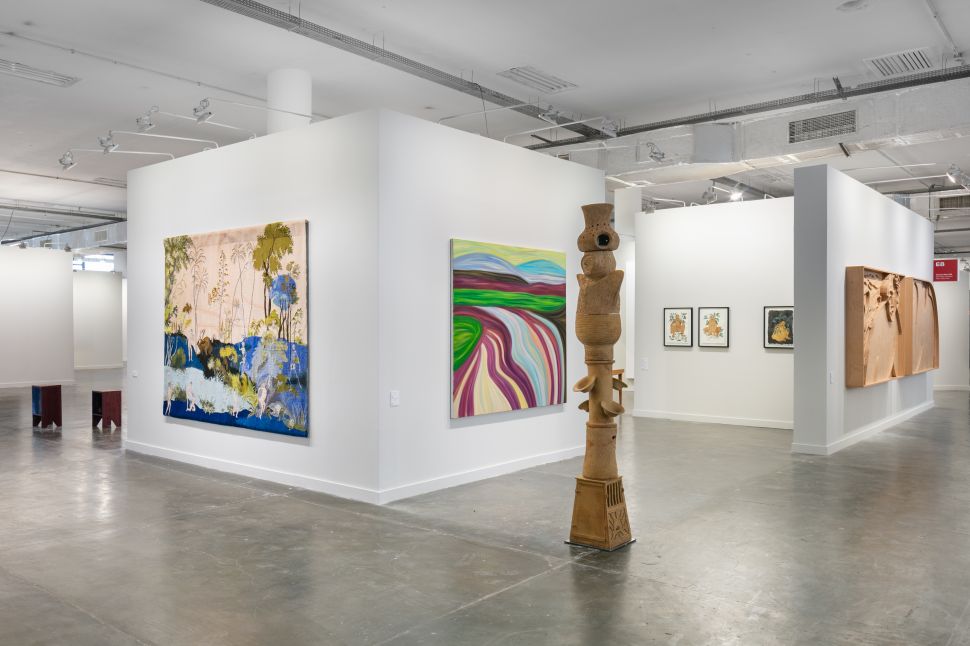



Beyond the blue-chip and established names, there was no lack of discoveries and space for experimentation at the fair. Among the more compelling propositions, in the booth of VERVE Galeria, Brazilian artist Mayara Ferrâo presented a new series of vintage-looking A.I.-generated photographs of LGBTQ couples from the past, each encased in antique frames. Using A.I. as a tool to question archival structures and the way history has been written—often with many stories erased—Ferrâo engages with technology as a method of rewriting the past. The works, each priced at R$6000 (around $1,000), offered a strikingly intimate and poetic revision of memory. In the same booth, VERVE also presented a group of captivating new paintings by the young and promising Victor Fidelis, each priced around R$25,000 (approximately $4,500).
Slightly higher in price range but with a similarly promising trajectory, Galeria Luisa Strina was showing work by Panmela Castro, a Brazilian artist who began her career in graffiti and is now increasingly sought after for her richly textured and sensually charged paintings. Medium-sized canvases remained priced under $20,000. Castro recently entered the Pérez collection following a residency last year at Jorge Pérez’s private museum and incubator El Espacio 23.
The strong interest in younger and emerging artists translated into immediate results. Dealers reported multiple early sales, especially at São Paulo-based Mitre Galeria, whose dynamic program nearly sold out by the end of the first day. The booth featured works by Wallace Prato and Marcos Siqueira, as well as a series of enigmatic portraits by Éder Oliveira, all priced under $15,000. Oliveira is also currently the subject of a solo exhibition at the gallery, timed to coincide with the fair. “We had great confidence in the strength of our presentation at this edition of SP–Arte and the public and market reception confirmed it,” Flávia Cardoso, assistant director of the gallery, told Observer. “This was our most successful first day in terms of sales since we began participating in the fair.”
Mitre also reported sustained interest and additional sales for Luana Vita, who will soon open a solo exhibition at the Sculpture Center in New York. The gallery is also preparing to present her work in a solo booth at Frieze New York in May.
Meanwhile, another São Paulo-based gallery, Luis Maluf, reported several sales by early afternoon, including a more ambitious interactive spiritual sculpture by Netherlands-born and Brazil-based artist Janet Vollebregt. The Quartz Rose Diapason Portal, conceived as a tool for sound bathing aimed at producing alignment, stood out among the booth’s offerings. “We are always amazed by the exchanges and the performance we experience at SP–Arte,” rep Paola Greco told Observer. “It is always a pleasure to present the gallery in our country.” Other smaller works by Vollebregt were also presented and sold, alongside pieces by Aline Moreno, Antonio Bokel, Korola Braga and Shizue Sakamoto, among others.
“The opening was a day to be celebrated,” Feitosa told us at the end of the day. “We saw an engaged audience, celebrating Brazilian art and design and doing business. It was a great start to the four days of the fair ahead of us!”
The quality and activity level at this edition of SP–Arte has certainly confirmed the strength and dynamism of the Brazilian art market, despite the ongoing political and economic challenges faced by the country and its dealers. While Brazil’s punitive tax system continues to be a significant obstacle to further internationalization—both of the fair and of the country’s art ecosystem—SP–Arte’s opening day demonstrated how the market has cultivated a sense of reliance and self-sufficiency, anchored by a strong and highly committed base of collectors.
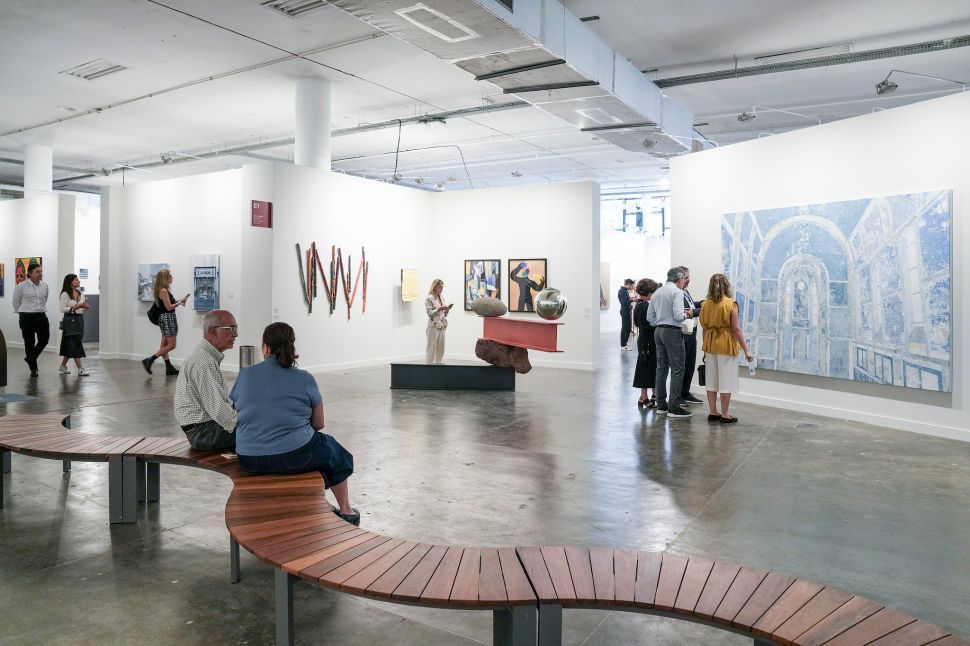



This post was originally published on this site be sure to check out more of their content

